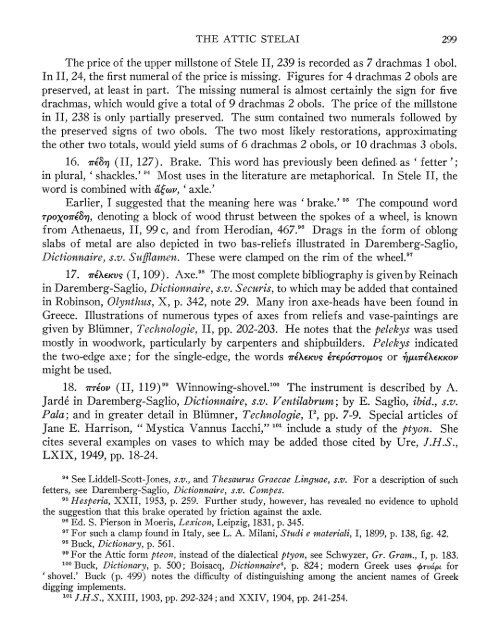the attic stelai - The American School of Classical Studies at Athens
the attic stelai - The American School of Classical Studies at Athens
the attic stelai - The American School of Classical Studies at Athens
You also want an ePaper? Increase the reach of your titles
YUMPU automatically turns print PDFs into web optimized ePapers that Google loves.
THE ATTIC STELAI 299<br />
<strong>The</strong> price <strong>of</strong> <strong>the</strong> upper millstone <strong>of</strong> Stele II, 239 is recorded as 7 drachmas 1 obol.<br />
In II, 24, <strong>the</strong> first numeral <strong>of</strong> <strong>the</strong> price is missing. Figures for 4 drachmas 2 obols are<br />
preserved, <strong>at</strong> least in part. <strong>The</strong> missing numeral is almost certainly <strong>the</strong> sign for five<br />
drachmas, which would give a total <strong>of</strong> 9 drachmas 2 obols. <strong>The</strong> price <strong>of</strong> <strong>the</strong> millstone<br />
in II, 238 is only partially preserved. <strong>The</strong> sum contained two numerals followed by<br />
<strong>the</strong> preserved signs <strong>of</strong> two obols. <strong>The</strong> two most likely restor<strong>at</strong>ions, approxim<strong>at</strong>ing<br />
<strong>the</strong> o<strong>the</strong>r two totals, would yield sums <strong>of</strong> 6 drachmas 2 obols, or 10 drachmas 3 obols.<br />
16. VE'8 (II, 127). Brake. This word has previously been defined. as ' fetter';<br />
in plural, ' shackles.' " Most uses in <strong>the</strong> liter<strong>at</strong>ure are metaphorical. In Stele II, <strong>the</strong><br />
word is combined with a'ecov, 'axle.'<br />
Earlier, I suggested th<strong>at</strong> <strong>the</strong> meaning here was 'brake.' <strong>The</strong> compound word<br />
rpoXorE'8r , denoting a block <strong>of</strong> wood thrust between <strong>the</strong> spokes <strong>of</strong> a wheel, is known<br />
from A<strong>the</strong>naeus, II, 99 c, and from Herodian, 467.96 Drags in <strong>the</strong> form <strong>of</strong> oblong<br />
slabs <strong>of</strong> metal are also depicted in two bas-reliefs illustr<strong>at</strong>ed in Daremberg-Saglio,<br />
Dictionnaire, s.v. Sufflarnen. <strong>The</strong>se were clamped on <strong>the</strong> rim <strong>of</strong> <strong>the</strong> wheel.97<br />
17. 1TE(XKV9 (I, 109). Axe.98 <strong>The</strong> most complete bibliography is given by Reinach<br />
in Daremberg-Saglio, Dictionnaire, s.v. Securis, to which may be added th<strong>at</strong> contained<br />
in Robinson, Olynthus, X, p. 342, note 29. Many iron axe-heads have been found in<br />
Greece. Illustr<strong>at</strong>ions <strong>of</strong> numerous types <strong>of</strong> axes from reliefs and vase-paintings are<br />
given by Bliimner, Technologie, II, pp. 202-203. He notes th<strong>at</strong> <strong>the</strong> pelekys was used<br />
mostly in woodwork, particularly by carpenters and shipbuilders. Pelekys indic<strong>at</strong>ed<br />
<strong>the</strong> two-edge axe; for <strong>the</strong> single-edge, <strong>the</strong> words 1TEAXKV9 4TEPOOpTO,.oo or -q(tLLTEXEKKOV<br />
might be used.<br />
18. TrrEov (II, 119)99 Winnowing-shovel."'0 <strong>The</strong> instrument is described by A.<br />
Jarde in Daremberg-Saglio, Dictionnaire, s.v. Ventilabrum; by E. Saglio, ibid., s.v.<br />
Pala; and in gre<strong>at</strong>er detail in Bliimner, Technologie, I2, pp. 7-9. Special articles <strong>of</strong><br />
Jane E. Harrison, " Mystica Vannus Iacchi," 101 include a study <strong>of</strong> <strong>the</strong> pt5yon. She<br />
cites several examples on vases to which may be added those cited by Ure, J.H.S.,<br />
LXIX, 1949, pp. 18-24.<br />
94 See Liddell-Scott-Jones, s.v., and <strong>The</strong>saurus Graecae Linguae, s.v. For a description <strong>of</strong> such<br />
fetters, see Daremberg-Saglio, Dictionnaire, s.v. Compes.<br />
95 Hesperia, XXII, 1953, p. 259. Fur<strong>the</strong>r study, however, has revealed no evidence to uphold<br />
<strong>the</strong> suggestion th<strong>at</strong> this brake oper<strong>at</strong>ed by friction against <strong>the</strong> axle.<br />
96 Ed. S. Pierson in Moeris, Lexicon, Leipzig, 1831, p. 345.<br />
97 For such a clamp found in Italy, see L. A. Milani, Studi e m<strong>at</strong>eriali, I, 1899, p. 138, fig. 42.<br />
98 Buck, Dictionary, p. 561.<br />
9 For <strong>the</strong> Attic form pteon, instead <strong>of</strong> <strong>the</strong> dialectical ptyon, see Schwyzer, Gr. Gram., I, p. 183.<br />
100 Buck, Dictionary, p. 500; Boisacq, Dictionnaire4, p. 824; modern Greek uses eTrvapt for<br />
'shovel.' Buck (p. 499) notes <strong>the</strong> difficulty <strong>of</strong> distinguishing among <strong>the</strong> ancient names <strong>of</strong> Greek<br />
digging implements.<br />
101J.H.S., XXIII, 1903, pp. 292-324; and XXIV, 1904, pp. 241-254.
















